Genre: Beat-’em-up Developer: WaterMelon Publisher: WaterMelon Players: 1-2 Released: 2020
WaterMelon’s latest release was both one of the most anticipated and one of the most controversial projects the small retro-gaming community has seen in development for the Sega Genesis. Originally announced under the working title of Project Y way back in 2012, the development of WaterMelon’s follow-up to its original Mega Drive RPG effort Pier Solar was certainly surrounded by lots of drama, confusion, and, as it appears, lots of infighting between fans of the project and even internally among its developers alike, leading many to believe that this game would never see the light of day. But Christmas season 2020 brought quite the unexpected gift when it was announced that, after spending a good eight years in development, the first copies of Paprium (as the project would end up being named) were actually being shipped. While there is still some controversy surrounding the technical qualities of the end product – evidently the first batches of the cartridges are incompatible not only with modern Genesis clones like the Mega SG but also with certain pre-TMSS variants of the original hardware – one fact remains: The game, despite all naysaying, actually exists.
Paprium is very much a product of its time – in more than one aspect. The previous decade was a time ripe with late 1980s/early1990s nostalgia; fan productions like Kung Fury and game releases aiming at a certain retro demographic like Far Cry: Blood Dragon or Double Dragon Neon were virtually basking in the neon pink-and-purple glow of that particular era, when consoles and computers were first entering homes, and techno music and cyberpunk were entering public consciousness and bringing a certain “Tech Noir” aesthetic with them that anyone growing up in that time is intimately familiar with. Had it come out five years ago, Paprium would certainly still be riding high on that wave. Not only is it a beat-’em-up in the vein of the most popular 16-bit-video game classics like Final Fight or Streets of Rage, its whole presentation screams ’90s era edginess. From the color scheme in bright neon pink, green and purple hues; its electronica soundtrack; its cyberpunk-ish, post-apocalyptic setting; to the make-up and design of its lavish packaging – even to its marketing (if you want to call it that) spouting claims like the cartridge being powered by a “Datenmeister” to supercharge the Genesis’ visual and aural capabilities kind of evokes Sega’s claims of the Genesis’ own “blast processing” feature. Too bad this game has come out in 2020 then, since that particular wave of nostalgia has mostly ebbed again. Still, if anything, this even gives us more of a chance to judge the game by its own merits.
And truth be told, the first impressions this game has to offer – once you’ve made it past the weird troll mini-game that is – are certainly impressive. WaterMelon promised to offer a visual feast, and on that front Paprium delivers sure enough. Right out of the gate, the game practically lavishes you with prime visual effects you weren’t expecting the Genesis could offer, starting with a literal splash of sprite scaling when one of the lead characters leaps into the action right when you start a new game. The playable characters move very fluidly, at least for the most part. The general movements are very well-animated, although some attack animations (particularly the “Bully” and desperation move attacks, but also the visuals when grabbing an enemy in a hold) seem very limited, even for 16-bit game standards. Back to the positives, fight scenes can have up to eight sprites on offer without stutter or flicker, there’s transparency and glow effects, as well as smooth multi-layered parallax scrolling, all present within the first stage of the game. It begs mentioning here though that the game cartridge does, in fact, possess additional chips like a 64MBit-NOR-flash ROM, an FPGA, and a 32-bit Microcontroller to provide. The capabilities of the FPGA and the flash memory combined may explain WaterMelon’s claim that the game ROM boasts a whopping 80 MEGs, more than doubling the typical Genesis limit of 32 MEGs – there must be a ton of on-the-fly preprocessing and decompression going on the cart itself in order to accomplish that.
All this accompanied by a lavish soundtrack provided by some very notable composers in the retro chiptune scene (David “Groovemeister303” Burton and Trevid “Jredd” Hughes, respectively). Some of the tracks stand great on their own and make for good, relaxed listening, too. There are a few occasions where the theme and mood of the music don’t seem to quite mesh with the ongoing action onscreen though – there are two rather calm and relaxed tunes with muzak-styling that for me don’t gel very well with the action of a tough brawler in a dystopian cyberpunk setting – but that may just be down to my personal tastes. Again, it’s thanks to the additional on-cart chipsets that helps out with optimizing the music output and even allowing for some trickery like on-the-fly pitch shifts during certain gameplay moments.
There’s something deeply ironic about this situation that I can’t help but mention. This cartridge for a console with a 16-bit-CPU is effectively powered by a 32-bit chip, post-2000s-era programmable logic that in itself may be capable of running a 16-bit-softcore CPU if one wished to do so, and a Flash memory IC with a speed and compression that wouldn’t have been available during the mid-’90s. In unison, that very chipset for the game is certainly in many respects more powerful, and certainly generations more modern, than the console it’s running on, which isn’t an illegitimate thing to do in my opinion. Many if not most modern retrofitting accessories for old hardware would fit that description. But at the same time, lead designer Fonzie took the time to intrinsically bash modern retro hardware like the Mega SG in an additional cover letter included with the delivered game, even going so far as to include a troll minigame that seems to be tailor-made as to specifically lock out that very hardware. Not a class act and pretty hypocritical if you ask me.
The gameplay itself, though, is unfortunately the weakest part of the package. It’s not exactly bad, but it could’ve used a lot of fine-tuning. The base ideas are typical for a ’90s era brawler, with a few extras that, while not completely unheard of in the 16-bit era, were at least quite uncommon. You have three selectable characters to start with – the huge and powerful but slow brawler type, the female character representing the stereotypical “agile-but-weak” option and another guy with all-average stats. The game is best played with a six-button-controller, although the controls themselves are laid out in typical brawler fashion. You’ll mostly use the C and B buttons for jumping and attacking respectively; hitting both buttons together allows for a limited backwards attack. Downed enemies can be attacked with – and only with – a downward strike, which on a six-button-pad gets its designated “Bully” button (Y). Using the A button activates Paprium’s version of the “desperation move.” On swallowing a (collectible) drug pill called “Blu” in-game, your character is granted a short frame of invulnerability with additional attack strength. This drug mechanic is interesting on paper. The more you use it, the more your life bar gets taken over by an increasing blue segment. Should your energy be low enough to enter this “Blu addiction” bar, your character sprite gets visibly exhausted and is thus slower and weaker when attacking. Some enemies also use weapons like chains, pipes, shock batons or knives that can be picked up and used against them.
So far, so ordinary, but in the finer details the game has a few notable quality issues that could’ve used fine tuning. Aligning with the enemy in order to attack them can be quite finicky, and it often seems like you can’t properly line up with them. The knockback when hitting and dropping enemies to the ground feels weirdly heavy and imprecise at times. It’s not too bad, but it feels slightly off. What’s worse, the playable characters themselves seem unbalanced as well. Muscular powerhouse Tug can plow through hordes of enemies with little problem and rarely seems really limited by his slower attack speed. Then again, difficulty is not too much of an issue. Even on the hardest difficulty, the entire game can easily be cheesed by using jump kicks, which do less damage but work perfectly well against every enemy (the only exception may be the flying armored mech types which don’t get knocked back by flying kicks, but that can easily be sidestepped). This even works against the bosses; should you run low on energy, using jump kicks exclusively is almost always a surefire way to end things without troubles. The enemy AI is also regrettably weak. Quite often, enemies just stand around without attacking you at all, other times you can easily get through entire sequences (and even some minor boss fights) by standing completely still and spamming the B button. The weapons are also very unbalanced (no need to pick up the pipe, ever. It’s so slow that attacking with it becomes more of a hindrance than practical. The chain’s limited reach is also not really worth it). Frankly, the gameplay is quite limited in this fashion and tends to turn rote, even a bit of a bore, especially if you just play the game in the quite linear Arcade mode.
The game design is also very uneven. It’s quite apparent that the designers (or at the very least, Fonzie himself) were/was more interested in creating a game along their own personal tastes, trappings and stylings rather than considering whether it’d make sense from a gameplay perspective. There’s the enemy design, for one. Many enemies look pretty par for the course for a -90s era brawler: Punks and mutants are to be expected, as are the track suit-clad athletic guys or the fat dudes who can usually take quite a lot of abuse. Other designs are more questionable though. There’s this one enemy type for example that represents a walking 1980s-era gay/BDSM cliché, almost to a painful degree: leather-clad, effeminate moves, more prancing than walking, suggestive taunt moves. It actually reminds me of a particular character: The Bare Knuckle 3 mini boss of stage one, Ash, has basically the same moves, looks and behavior, right down to the prancing jump kick attack. That character was deemed offensive even back in the ’90s so that the boss was replaced for the U.S. release of Streets of Rage 3, a decision not every gamer agrees with. It’s quite clear on which side of the fence Fonzie comes down on this matter. Some stages are virtually flooded with this enemy type. Another questionable entry into the roster are the flying boob bots that fire lasers from their breasts, as well as lots and lots of bare-chested dudes… I don’t know if someone wants to make a statement here or if that person has to work through a few deeply-seated issues. Frankly, it just seems very juvenile.
Even though the graphics in general are pretty great, most of the locations you visit are just not very memorable. The first squalid cyberpunkish street stage may look impressive, with some nicely detailed backgrounds and surroundings. But since about 80% of the stages look and feel pretty much in the same vein, in similar grey/green/neon pink hues, there is no stage environment that really stands out as particularly memorable. You may eventually be able to reach some really notable changes of scenery, with some very different and quite beautiful vistas, but in order to get there you need to play through the games several times, which to me felt like a lot of work due to the very limited and one-note core gameplay.
There are also a few minor niggles that just seem to have been included for the heck of it but contribute nothing to the game itself. Why are all numbers in the game, from the scores to the characters ages, the year the game is supposed to take place in, even the page numbers in the manual, in hexadecimal? There’s no in-game reason for this and all it accomplishes is that numbers are more difficult to parse. Why can I only attack a dazed person that’s visible seeing stars with a downward attack if he or she is still standing upright? What’s my motivation for beating up cops, outdated gay stereotypes and flying boob-bots? Is it revenge, justice, or am I actually the bad guy trying to take over the city? Even the comic that’s in the box, at least in the investor’s edition, raises more questions than it answers. One playable character is introduced simply as a “guy they met in a bar,” that’s all. Apparently the chief of police in this “last city on earth” is corrupt, but since we never really learn anything about the place, who’s supposedly running the city or anything, the game might as well take place on the moon or another planet for all the difference it makes. Some of you might say “who cares about that, it’s a beat-’em-up?” Frankly, when I’m beating up speedo-clad dudes and robots with huge breasts for no apparent reasons, it’s hard to feel like the good guy in these proceedings. Why do I only get three save games, and why do I lose everything I unlocked after a playthrough if I have to delete my save game (and you will have to delete it at some point, because once you’ve finished the game to the very end in one save slot, all characters get locked down and you can’t continue with that save state).And many of the graphical touches are really just pointless trappings that contribute little or nothing to the gameplay itself, like when zoomed-in enemy sprites are walking across the foreground of the screen. It’s got a lot of style, sure, but in terms of gameplay, it’s lacking substance.
Which is not to say that there is nothing of substance to the game. There are notable additions. The first is only accessible for owners of a Sega CD. Like with Watermelons first game Pier Solar, Paprium can also detect whether a Sega CD console is attached to the Genesis. If so, a player can opt to have an AI partner join the fray and help him out, who is then controlled by the console add-on’s CPU. It’s not unheard of in early brawlers. My personal first thoughts went to Guardian Heroes on the Saturn, but AI-controlled second players were also around in the 16-bit era, the most famous example probably being Final Fight 3 on the SNES. I believe it’s unique for a Genesis game, at the very least. The AI is quite decent but given the low overall difficulty of the game it’s not that useful to actually have around.
The second thing are unlockables. You can find secrets, new routes through the games, and unlock hidden outfits and even entire characters, at least one of which is actually necessary in order to access the hidden final areas of the game. Those were also around on other 16-bit brawlers like Streets of Rage 3, but certainly not in the sheer amounts Paprium has to offer. Unfortunately it’s not very apparent what one needs to do or when a condition is fulfilled to unlock certain things. Even the manual is only of little help here, and if there are hints in the game itself, they are very obscured. Some of the unlockables, like the game’s true ending, are indeed on the more memorable side of the game. But to get those you have to play through the game very often, and if – like me – you find the core gameplay too similar and unappealing, actually getting that far and pushing yourself to yet another playthrough might turn into more of a chore than actual fun. But in order to see the only halfway decent ending this game has on offer, you will have to do so.
All in all, Paprium is a mixed bag. The Game sure tries its hardest to stand out. Does it succeed? Looking at it purely from the perspective of a game from the Genesis library, then sure. It certainly has the most impressive graphical capabilities within the console’s existing library, and the soundtrack is quite exquisite, even if it sometimes fits ill into the ongoing action and lacks a certain je-ne-sais-quoi that would make it a recognizable as a Genesis sound. From a game design perspective though, I can’t help but find the game somewhat lacking. Sure, Paprium has quite a lot of unlockables and secret routes on offer, but those really only come into play on repeat playthroughs, and the core gameplay loop is just too rote to keep a regular player motivated for those. As amazing as the optical first impression is, with its smooth scrolling, parallax effects, and the occasional sprite scaling, these are all just neat dressing that in the long run don’t serve to cover up the flaws inherent in the core design. From a pure gameplay perspective it never really reaches the heights the best beat-’em-ups of the platform have on offer. It’s true that Streets of Rage II, Final Fight CD, and Golden Axe were released some 25 to 30 years ago, but I know which games I’d rather give another replay five years from now. To be fair though, the Genesis library also has much worse brawlers in stock. And if anything, Paprium makes for an impressive technical showcase to demonstrate what neat tricks can still be teased out of that old fourth generation warhorse – given the right additional on-cart hardware, of course. Purely seen as a Genesis game, I feel safe to say that Paprium can be considered good – great presentation with decent enough gameplay. But it’s still a far cry from greatness. Is it worth the $170 U.S. (or more) Watermelon is asking for for an additional pre-order run? Let’s just say I’m glad I never forked out more than the initial investment back when I was still simply known as Project Y.
(The screenshots were taken courtesy of a video stream by Sega-16 member DevilN. You can see the game in action on his twitch channel).
Score: 7

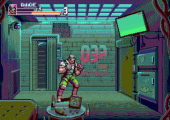
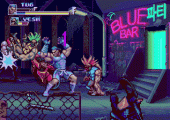
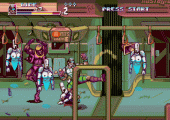
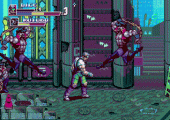
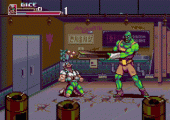
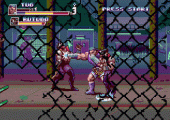
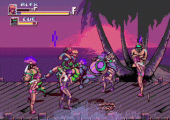
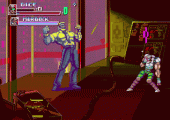
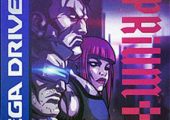
Recent Comments